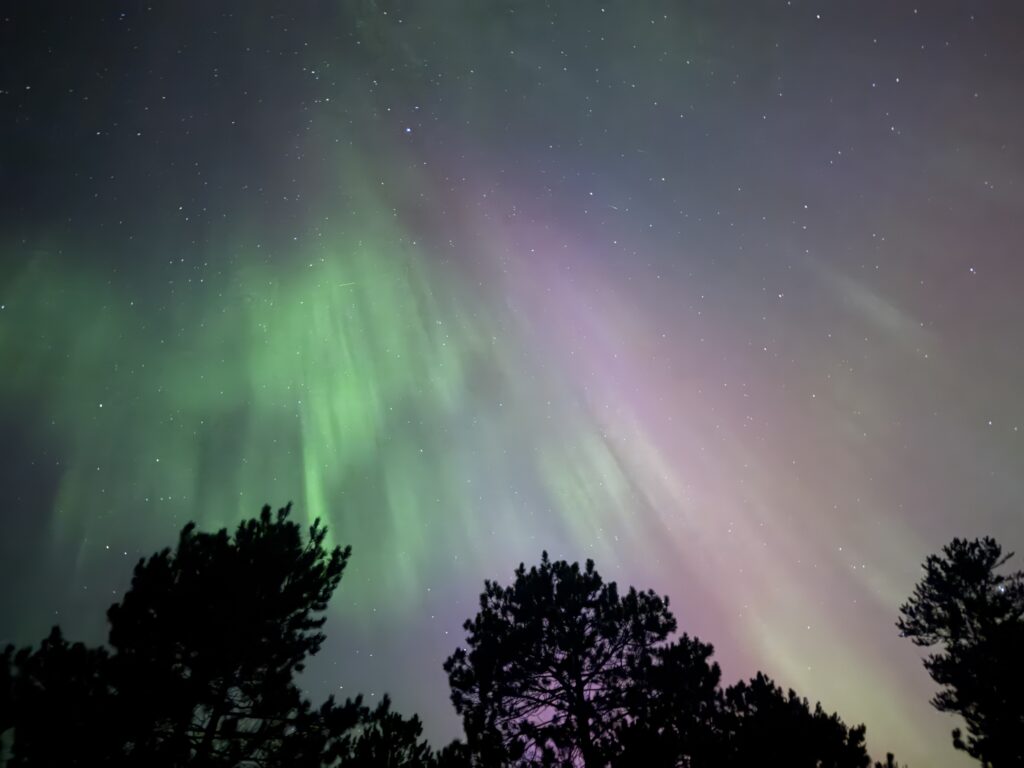
2025 Northern Lights Update
Up until recently very few people took pictures of the northern lights. The equipment needed was expensive and the process somewhat unknown. Now that most phones have night photography settings almost anyone can take a picture of the northern lights if they are lucky enough to see them. I love this. I love that everyone up here at Birch Forest Lodge can take their own pics and feel the joy and pride that comes when you share your very own pictures with friends and post them on social media.
This time of year we get a lot of questions and calls about how to see the Aurora Borealis or Northern Lights. And if you follow us at all, you are probably aware that we have numerous blog posts about the topic as well some how to see the northern lights guides on our website. And of course our instagram and facebook pages have tons of pics. And last spring, I(Adam) wrote an article for the statewide Minnesota Resort Association, which was published on their website. So we get it, you found us and now you want to know how to see them. Today I’m going to go over a few basic points again.

First, lets talk best time of year…
September. That is the key. Why? Because the weather is relatively stable and we have more than 5 hours of darkness. Seriously, it is about that simple. You need dark skies. May, June and July have way too much daylight. Sure, we might have them at 2 or 3 am, but I’m not getting up for them. I prefer it when it is 9 pm and I still have my shoes on! What about the winter? You are correct, it is very dark in the winter. But that brings us to my statement about stable weather. In the winter it is often cloudy. So what you are looking for is enough dark sky at night to give you a chance and clear skies. Sure, we get some storms and sometimes we go a few days without seeing the stars, but we get quite a few clear night skies as well. In my opinion, we have more clear skies than cloudy skies during those months. So which months are best? According to Adam’s opinion only, it would be-September, April, October and August, with September being the favorite.
Dark Sky. Okay, now that you know the when, lets talk about the next key element. You need really dark skies. No light pollution. No city lights. No porch lights. I can’t tell you the number of times I see people trying to stargaze on their porch or deck while the exterior lights are on. You need to turn off all lights. Make it dark. Your eyes will adjust and you will see way more! So, now that the porch light is off, don’t forget about the moon. It kills me when I have a group arrive here and they are super excited to see the northern lights and they’ve done some research and chose to come to northern Minnesota and forgot(or didn’t think about) the moon. We almost never see the northern lights during a full moon. Target the new moon.
So there you go, that is the recipe. Dark sky, new moon, Fall and go north if you can. Okay, but you might be wondering, when is the absolute best chance? Well, there is a phenomenon called the Russell McPherron effect that says during an equinox(September and March), northern lights are far more likely to occurr due to the earth tilting and creating holes in the magnetic field above the poles, than any other times of the year. My experience with hundreds of nights watching the auroras is that this very accurate. The single best time to predict seeing the aurora borealis is on September 20/21. Fortunately for us, this year the new moon is on September 21! Woot, woot!!!
And yes, there is a solar cycle that takes abou 13 years to complete, and during that cycle there are years(solar max) that have much more northern light causing solar activity than down years(solar minimum). Where are we right now? We are in solar max. So this coming weekend, we will have solar max conditions, a new moon and an equinox. All we need are clear skies and a little solar wind…
You might be wondering, does that mean we’ve seen many northern lights this fall so far? Well, let’s get you some pictures from last night…


And here are some pics I took of the northern lights during different times this past month..




As you can see, there is quite a bit of differences. Each solar storm is different. Some are stronger and the vibrancy of the light and whether we see color or just silvery/white glow is a direct impact from the intensity of the solar storm. Some of the pictures are during partial moons. You can tell because the colors are somewhat washed out. But on those nights where we get dancing lights in the sky that are unexpected, we don’t complain!

